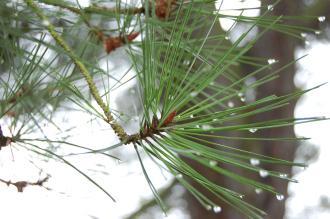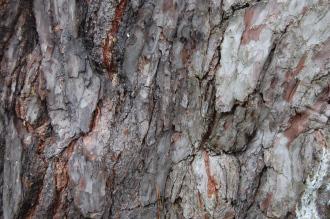
Pinus muricata (06/01/2013, Kew Gardens, London)
Position: Full sun
Flowering period: Summer
Soil: Moist, well drained
Eventual Height: 24m
Eventual Spread: 8m
Hardiness: 8b – 10b
Family: Pinaceae
Pinus muricata is an evergreen tree with a rounded crown. Its blue/ green leaves are in the form of needles, appear in pairs and are up to 15cm long. Its branches are spreading and often ascending. Its trunk may achieve a diameter of up to 1.2m. Its dark gray bark is deeply furrowed and has scaly plates. Its monoecious orange flowers are in the form of pollen cones and are up to 5mm long and are not self fertile. Its fruit are in the form of cones, appear in groups of up to 5, are up to 10cm long and have distinctive spines on some of its scales. Its cones may persist on the tree for up to 70 years.

Pinus muricata Leaf (06/01/2013, Kew Gardens, London)
Pinus muricata, commonly known as the Bishop Pine, Prickle Cone Pine or Dwarf Marine Pine, is native to the south west coastal regions of the USA and a few locations in Mexico. Pinus muricata is considered to be Near Threatened according to the IUCN Red List of Threatened Species.
The etymological root of the binomial name Pinus is the old classical name for ‘Pine tree’. Muricata is derived from the Latin murex a type of spiny sea snail, in reference to the spines found on the cones.
The landscape architect may find Pinus muricata useful as a medium sized evergreen tree. Once established this tree is drought tolerant. It is tolerant of maritime conditions.
Ecologically, Pinus muricata seed cones are eaten by some mammals.

Pinus muricata Bark (06/01/2013, Kew Gardens, London)
The Royal Horticultural Society has given Pinus muricata their prestigious Award of Garden Merit in 1993.
Pinus muricata prefers moist, well-drained soils. It prefers an acid to neutral pH of soil. It tolerates dry rocky soils.
Pinus muricata requires little maintenance.

